The City Surfer Risen
From Stab issue 68: Fab happenings in NYC. Surf ascendant. A culture born. Stab sent our man to the city to learn all about it. Words by Tom Fjord It’s down on the East River in Brooklyn, New York, next to high-rises and a joint serving espresso drinks called Fuck Sleeps. The nearest wave is an hour away. So Pilgrim is far from the surf — but not from the surfers and this is what brings us to the neighbourhood. New York, y’must now know, is a surf town, straight up, and while the time has long past to indulge in wonder at this discovery of a surf scene in Gotham of all places, like, wow! — still, something special’s happened in the city these past few years. It’s having a moment of such grand influence and visibility in our lil world that Stab just had to peer in. We begin, as so many New York surfers have, with Mr. Chris Gentile. “It’s true. I think it’s really having a moment,” says Gentile, owner of Pilgrim Surf + Supply, receiving us in the office beneath his popular Williamsburg shop. “[Surfing is] really quote/unquote in fashion. It’s evident – take a walk down Broadway and peek in J. Crew’s window right now. Their teams come by [Pilgrim] and look at stuff and say, ‘Ooh,’ and get inspired, and go plug it into their seasonal treatment.” And oh, they sure do! Fins in the windows, Lightning Bolt on-shelf and, two days before our basement rendezvous with Mr. Gentile, the release of a new J. Crew vintage surf capsule collection “inspired by images of Saint Tropez and Biarritz in the ’50s.” Why not! The mass fashion behemoth has taken to the surf like club kids to molly, and it’s hardly alone: Emma Stone poses with a board for Revlon in the new Vanity Fair that’s provided Stab’s in-flight entertainment to JFK and there’s Pipeline’s Dan Fuller modelling worldwide for Chanel, and we could just go on. “If you spent the day going around to the big retailers, just went down Madison Avenue and Broadway and looked at stores, everybody is using surfing right now,” Gentile continues. “We’re having a renaissance.” He’d know. Gentile ain’t riding the bandwagon here, folks; he tuned the engine. He’s at the wheel. This “renaissance” in which surf has become a lifestyle motif for hip New Yorkers from the bottom up, from Pratt student to the eds at Vogue, is a future Gentile hath wrought. “Chris is a really important player in New York surfing,” says Tyler Breuer, founder of the New York Surf Film Festival and a genuine lifelong local – something so few New Yorkers can rightly claim to be. “When he opened Mollusk” – Gentile’s first shop, which in ’07 preceded Pilgrim but was in the same ‘hood – “there was no real surf shop other than the Quiksilver store. They brought a lot of the community together, a lot of people who weren’t surfing yet. They really tried to educate people on surf history, culture, educate them on the board designs.” There’s a window in the New York Summertime-fall cycle when the hurricanes are firing and the water’s as warm as a bath thanks to the Gulf stream. But, here? in late spring, before the Gulf stream hits? sweep yourself into rubbers of thickness. Photo by Matthew Clark “He’s been a huge advocate of this sort of urban surfing meets more, I don’t know, more of a style,” says Mikey DeTemple, an NYC-based pro (Hurley) and filmmaker also with roots in the city. “I would say he’s one of the guys who has really shaped this whole thing. He was the one who brought surf to Brooklyn — there was never a surf shop in Brooklyn. People were like, ‘What the fuck is that?’” Gentile, 40, arrived in the city in 2001, after art school and travel. At the time even he didn’t know the depth of the scene. “But then I started meeting these people in the water, forging these friendships, and I started realising, ‘Shit, there’s this incredible body of surfers here, but none of them wear it on their sleeve.’ At the time the culture was kind of just stained. Coming out of the ’90s, it was like the Spicoli effect, where everyone associated surfers with burnouts or cheese-balls. So nobody really wanted to flaunt it.” For his part Gentile won’t flaunt it either, even now that the “stain” he describes is ancient history. He looks the surfer, f’sure, but it’s mature and understated. When we meet he’s wearing a hat but neither five-panel nor fitted — just a baseball cap that hints at no fashion save the practical need for facial shade in June. His chinos are basic. An Innermost Limits of Pure Fun tee is pulled across his paddler’s frame. He looks like he surfs but not, and forgive this bit of semantics, like “a surfer” – not in the uniform throwback style that marks his employees and customers and those of his foil across the river, Saturdays Surf NYC. The semantic hair-splitting hides a key point, though. When there’s talk of this New York moment, this rise of the urban surfer, it’s largely a talk about fashion. Threads. Even the salted coif of beach hair that’s now bottled for everyone in high-end beauty products. Surfing in this city has grown but at the same fabulous time, the look, the idea, of surfing has exploded, far outpacing the lesser phenomenon of actually riding a wave. These are two linked but very different things. Stab, for our part, we’re unabashed fans of both – but we emphasise: they’re separate. “The worst people just say they do it and really don’t,” says Gentile. “They’re wearing it on their fucking sleeve. Like (artists) who walk around town casually in pants with paint all over them, you know? Now that’s been replaced by someone walking around with a shirt that says something like ‘Surf New
From Stab issue 68: Fab happenings in NYC. Surf ascendant. A culture born. Stab sent our man to the city to learn all about it.
Words by Tom Fjord
It’s down on the East River in Brooklyn, New York, next to high-rises and a joint serving espresso drinks called Fuck Sleeps. The nearest wave is an hour away. So Pilgrim is far from the surf — but not from the surfers and this is what brings us to the neighbourhood. New York, y’must now know, is a surf town, straight up, and while the time has long past to indulge in wonder at this discovery of a surf scene in Gotham of all places, like, wow! — still, something special’s happened in the city these past few years. It’s having a moment of such grand influence and visibility in our lil world that Stab just had to peer in.
We begin, as so many New York surfers have, with Mr. Chris Gentile. “It’s true. I think it’s really having a moment,” says Gentile, owner of Pilgrim Surf + Supply, receiving us in the office beneath his popular Williamsburg shop.
“[Surfing is] really quote/unquote in fashion. It’s evident – take a walk down Broadway and peek in J. Crew’s window right now. Their teams come by [Pilgrim] and look at stuff and say, ‘Ooh,’ and get inspired, and go plug it into their seasonal treatment.” And oh, they sure do! Fins in the windows, Lightning Bolt on-shelf and, two days before our basement rendezvous with Mr. Gentile, the release of a new J. Crew vintage surf capsule collection “inspired by images of Saint Tropez and Biarritz in the ’50s.” Why not! The mass fashion behemoth has taken to the surf like club kids to molly, and it’s hardly alone: Emma Stone poses with a board for Revlon in the new Vanity Fair that’s provided Stab’s in-flight entertainment to JFK and there’s Pipeline’s Dan Fuller modelling worldwide for Chanel, and we could just go on.
“If you spent the day going around to the big retailers, just went down Madison Avenue and Broadway and looked at stores, everybody is using surfing right now,” Gentile continues. “We’re having a renaissance.” He’d know. Gentile ain’t riding the bandwagon here, folks; he tuned the engine. He’s at the wheel. This “renaissance” in which surf has become a lifestyle motif for hip New Yorkers from the bottom up, from Pratt student to the eds at Vogue, is a future Gentile hath wrought. “Chris is a really important player in New York surfing,” says Tyler Breuer, founder of the New York Surf Film Festival and a genuine lifelong local – something so few New Yorkers can rightly claim to be. “When he opened Mollusk” – Gentile’s first shop, which in ’07 preceded Pilgrim but was in the same ‘hood – “there was no real surf shop other than the Quiksilver store. They brought a lot of the community together, a lot of people who weren’t surfing yet. They really tried to educate people on surf history, culture, educate them on the board designs.”
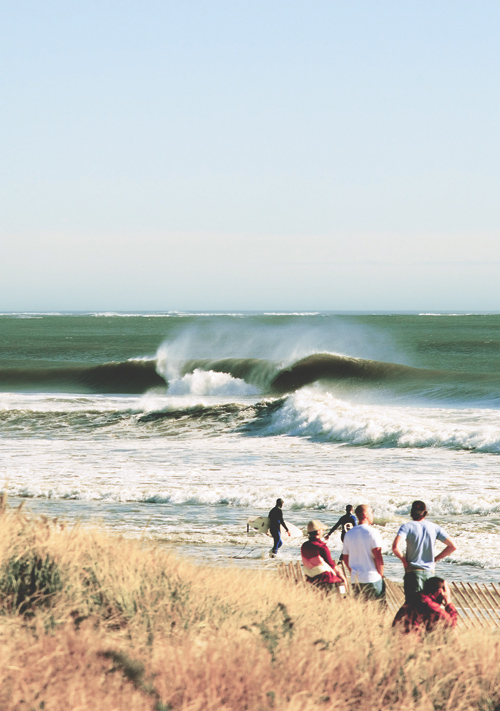
There’s a window in the New York Summertime-fall cycle when the hurricanes are firing and the water’s as warm as a bath thanks to the Gulf stream. But, here? in late spring, before the Gulf stream hits? sweep yourself into rubbers of thickness. Photo by Matthew Clark
“He’s been a huge advocate of this sort of urban surfing meets more, I don’t know, more of a style,” says Mikey DeTemple, an NYC-based pro (Hurley) and filmmaker also with roots in the city. “I would say he’s one of the guys who has really shaped this whole thing. He was the one who brought surf to Brooklyn — there was never a surf shop in Brooklyn. People were like, ‘What the fuck is that?'”
Gentile, 40, arrived in the city in 2001, after art school and travel. At the time even he didn’t know the depth of the scene. “But then I started meeting these people in the water, forging these friendships, and I started realising, ‘Shit, there’s this incredible body of surfers here, but none of them wear it on their sleeve.’ At the time the culture was kind of just stained. Coming out of the ’90s, it was like the Spicoli effect, where everyone associated surfers with burnouts or cheese-balls. So nobody really wanted to flaunt it.” For his part Gentile won’t flaunt it either, even now that the “stain” he describes is ancient history. He looks the surfer, f’sure, but it’s mature and understated. When we meet he’s wearing a hat but neither five-panel nor fitted — just a baseball cap that hints at no fashion save the practical need for facial shade in June. His chinos are basic. An Innermost Limits of Pure Fun tee is pulled across his paddler’s frame. He looks like he surfs but not, and forgive this bit of semantics, like “a surfer” – not in the uniform throwback style that marks his employees and customers and those of his foil across the river, Saturdays Surf NYC.
The semantic hair-splitting hides a key point, though. When there’s talk of this New York moment, this rise of the urban surfer, it’s largely a talk about fashion. Threads. Even the salted coif of beach hair that’s now bottled for everyone in high-end beauty products. Surfing in this city has grown but at the same fabulous time, the look, the idea, of surfing has exploded, far outpacing the lesser phenomenon of actually riding a wave. These are two linked but very different things. Stab, for our part, we’re unabashed fans of both – but we emphasise: they’re separate.
“The worst people just say they do it and really don’t,” says Gentile. “They’re wearing it on their fucking sleeve. Like (artists) who walk around town casually in pants with paint all over them, you know? Now that’s been replaced by someone walking around with a shirt that says something like ‘Surf New York’ with some graphic treatment that looks like everyone else’s graphic treatment. I mean, it’s so affected, man, you know? I get it, but that truly is just fashion.”
So how did we get here, y’may ask? What’s put surf (both act and image) on such a heater in this quaint sorta-not-seaside Eastern hamlet? Baby, let’s go way back.
In the 1910s the Duke was already giving surf demonstrations out here and by the early ’60s there were shops, comps, locals, the whole gag. Tyler Breuer’s family owns the second oldest of those shops and Breuer grew up in the mix.”People seem to think surfing in New York is popular now but it’s nowhere near where it was in the ’60s,” he reminds us. “My dad used to be able to sell a thousand boards a month in the summer.”
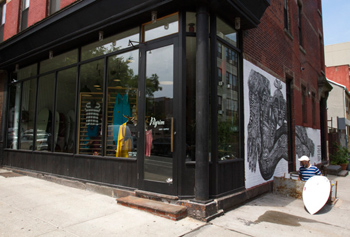
Pilgrim Surf And Supply, ground zero of the NYC surf movement.
“People have always surfed in New York,” agrees DeTemple, who, like Breuer, along with the seat of contemporary cool, lives today in Brooklyn. “It’s not something that just happened.” And this is truth – surf here’s hardly novel. But that’s not the whole truth, not the truth Stab has come to explore! ‘Cause there’s this strain of city surfer, see, so lately celebrated and empowered, urban but perhaps at times urbane even, that’s a recent development and so uniquely NYC. This wasn’t always so.
“When I think of New York surfing I think back to the core surfers I grew up with,” Breuer says, acknowledging the shift. “All blue collar, on Long Island. They’re the ones surfing every day, checking the waves, sacrificing social obligations to go surf.”
Tradesmen and labourers, these men – fishermen, folks who work with their hands, spiced with a dash of exurban money but largely working class: historically this group dominated the New York surf milieu. “They’re not into the scene, or being seen,” Breuer says. “They just want to surf and fuckin’ smoke pot, most of them, you know? These are the core guys. And there’s not a lot of them left.”
Long Island is where surf happens in New York, capped by Montauk in the east with Long Beach and Rockaway further west, the three major surf burgs since forever. Here surfers are entrenched, dug into the landscape, necessarily gritty and unmoved by the temper of 5th Ave creative departments. Authenticity defined!
But in recent years, says Breuer, and for reasons diverse like the riders on an L train, “The city surfer has grown exponentially. Whereas the Long Island surfer has actually probably fallen off a little bit.”
“Before it was kind of a core, dirty little scene,” says Joel Tudor, surf icon, world champion logger, former resident of Manhattan’s West Village. “The city was kind of corny if you were a surfer.”
Tudor first hit New York in the early ’90s, way pre-explosion, pre-Mollusk et al and found the scene here still in beta.”It was kind of like your own private little world,” he says, “and the waves at that time were completely empty. I’d surf by myself and come back and tell my friends (in California) and guys were like, ‘You’re full of shit.’ I’m like, ‘All right, fine, there’s nothing.'” Part of this void was technological. Getting to the beach from Manhattan ain’t so easy, then or now, and without the modern slate of surf cams to guide and coax a man to the lineup it was a mission and a gamble to go surf. Too many hurdles for all but the keenest citizen to hop with regularity.
“It’s really a commitment to go surfing in the city,” says surfer/model/artist Danny Fuller, who’s lived and surfed here on and off for a decade. “You know, even if you have a car it definitely takes about half the day.”
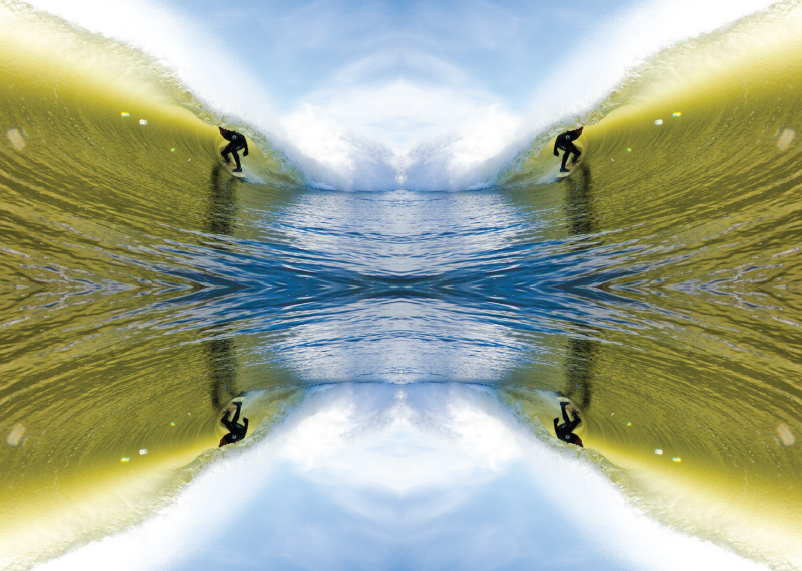
Andrew Doheny gilded like a little mirror set in the frame of a Jersey baby cavern. Photo by Tom Carey
“Here if you want to surf and get good waves, then you really have to work for it,” says DeTemple, who’s just wrapped a three-hour session when Stab finds him on a Friday. “It’s like a part-time job. It’s still East Coast. It’s not like this is California where you can surf all the time.” DeTemple’s watched the scene evolve since childhood and says today, “It’s a little shocking actually to go back and think about it. When I was in high school, I guess it was around ’97, I’d be driving to the beach with boards on the roof and see someone else come in the other direction, and they’d either wave or give you a thumbs up or thumbs down whether the surf was good. It was so small, and surfing was such a weird thing.”
“The audience for (surfing) in New York and the education, as far as people in the city knowing about waves and Surfline and all that shit, didn’t exist,” says Tudor. “So a lot of the conveniences of being a surfer back then were not afforded, and a lot of this new crowd has been able to benefit from all of those luxuries that exist now.”
In other words, trends notwithstanding, it was just a bitch to surf here one or two dozen years back. Even the wetsuit tech required to love a New York winter is fairly new. “When I was a kid they didn’t make 5-mils for a 14 year old,” says DeTemple, “But now you’re warmer out in the water than you are walking down Broadway in the middle of January.”
So this explains much, no? Good forecasts and equipment and resources in the city have sunk barriers to surfing lower than ever before. Like, subterranean! Why wouldn’t it get big? Surfing here still ain’t easy and may never be thanks to the cold, the distance, the inconsistency, and yet with shops and board swaps and film screenings and the illustrious New York Surfing Buddies, a group that advertises, “Looking for buddies to go out surfing with? All levels are welcome including newbies. We host weekly surfing meet-ups at Rockaway, Long Beach and Lido,” it’s much simpler, as a practical matter, to get onboard. So there’s that. But also and more effectually surfing’s just sexy, y’know? And NYC is sexy, and any collab between the two was always gonna fly off the shelf.
“Montauk and all that shit was just, like, a grungy little, what did they call it? It was a quaint little drinking town with a fishing problem,” says Joel Tudor of that most eastern tip of Long Island, past Gatsby’s Hamptons. Montauk! Let’s go there now ’cause if y’could put a geographic face on the city surf scene apart from the Crosby Street surf/coffee shop Saturdays NYC, in SoHo it may as well be Montauk.
“And it was all these cool artists,” Tudor goes on, recalling his ’90s exposure. “Peter Beard was there and, fucking, we were running around eating mushrooms on his property, surfing the Warhol estate. I mean, dude, it was a crazy time.”
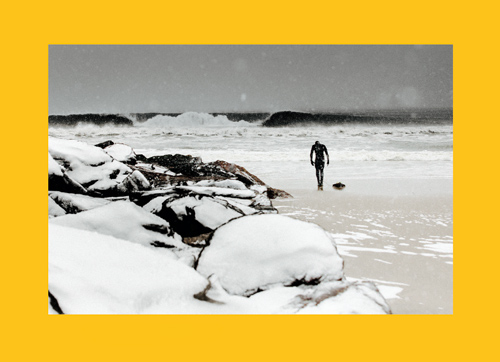
Even with the Earth buttered by snow and your body visibly quivering, the surf forever beckons. Bow your head before you throw yourself into the unbelievable cold (Iceland is only four hours away, if you wanna know).
“Montauk has always drawn that type of crowd,” says DeTemple, who keeps a studio there. “It’s the closest thing to Malibu. You ask people what they do and they’re art directors or editors. Even in the ’60s with Andy Warhol and Paul Simon and all these artists, they always came out to get away from New York City, and over time it’s just gotten more and more popular alongside surfing in general. It’s everyone’s great escape out here.”
If it sounds like fun and glamour, the idyllic summer beach town to incubate a haute surf/social scene and place it on display – doll, that’s what’s happened! What Montauk and other Long Island hubs provide is a sort of safe and glossy setting, a petri dish to cultivate this new wave of urban surf fans. Often they’re inexperienced or fair-weather – understandable! Cold winters! – drawn chiefly to the, mmm, the “lifestyle” elements of surf.
“You’ve got this whole beginner crowd in New York and they’re frothing,” Tyler Breuer observes, “but they don’t have a whole lot of knowledge and there’s this thing where they all surf maybe three spots. They surf Rockaway, maybe Long Beach, and they surf Montauk. That’s it. A lot of city surfers are almost like sheep, they flock to where it’s convenient and easy for them, where there’s other surfers, so they feel comfortable if their skills aren’t quite there.”
“(Montauk) used to be this very quiet town where most people didn’t even make it out there, or they lived there year-round,” says Danny Fuller. “And then a few places opened up, like the Surf Lodge” – a chic surf-themed beach motel – “and it became this destination, like, the hip place to go hang out with all the cool people. It went from a very quiet little town to just Range Rovers lined up for days and people kind of fighting for parking. I doubt there’s even standing room on the beach these days.”
“I’ve definitely seen surfing quadruple in Montauk with the full city takeover come Memorial Day,” says DeTemple of the summer rush. “The town goes from 5,000 to 75,000 and I would say it’s more than half city people.”
Montauk, then, becomes almost the runway for a certain city surfer to strut upon, hardly the sole spot to dip fins but a visible one, brimming with cachet, a sterling illustration of the great nexus of surf as sport, scene and fashion statement in New York.
“Now you have this entire new group of people that may not have been involved in surfing or interested in it that are starting to,” says Fuller, “because it’s kind of the cool thing to do. They got their Saturdays kit, their groovy retro board, even though they’ve maybe never surfed a day in their life and might not even catch a wave. They got their little tote bag and their Birdwell shorts and their whole look. You kind of see it a lot out there.”
But Fuller doesn’t for a second patronise! He supports. He celebrates. “The more people get out there and get that experience, they absolutely fall in love with it,” he says. “The more people that can share that, the better.”
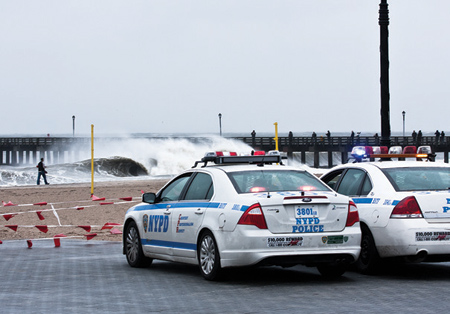
Dirty NYC and tubes you may find difficult to believe. Consistent? Not even close. But when it’s on, their girth will raise a lather of sweat.
Now it’s hard to overstate fashion’s impact on this palpable boom in New York surfing. And certainly, when the tides of taste go out and surf is no longer the in thing, there may be a contraction. But not a holocaust. As Pilgrim’s Chris Gentile says, “We’re not in this because it’s a trend. And surfing” – the act itself, not the look or the lifestyle – “isn’t a trend. It just isn’t.”
Meanwhile, what’s the harm in his shop, or Saturdays, or even ol’ J. Crew, for that matter, outfitting surfers of any postal code or skill level with some respectable gear? This moment is if nothing else a sartorial gift to surfers everywhere, should they choose to accept it. New Yorkers, especially, can enjoy the ride.
“You can say whatever you want but it’s kind of a cool time to be a surfer in the city,” says Tudor. “That’s my take. I can go pick up booties from Patagonia (in SoHo). Good luck, back in the day. You’d have to go to some weird, corny shop that sold Rollerblades and shit to try and find surf stuff. Now you can go somewhere there might be a cute girl that wants to talk to you about surfing.”
And as Gentile reminds us in parting, in his basement that was once a true Prohibition-era speakeasy complete with secret tunnel, as hip kids browse and lust on the shop floor above, surf ain’t about a look anyway.
“People who really surf here, they look like everybody,” he says. “They’re firemen, they’re me, they’re the most incredible artists in the world, they’re the NYPD guy who’s on the dive team that comes in here. There’s every ethnicity that surfs. There’s more women surfing here than anywhere I’ve ever seen. It’s everybody. It’s New York. It’s a cornucopia of humanity and it’s fucking awesome.”














Comments
Comments are a Stab Premium feature. Gotta join to talk shop.
Already a member? Sign In
Want to join? Sign Up